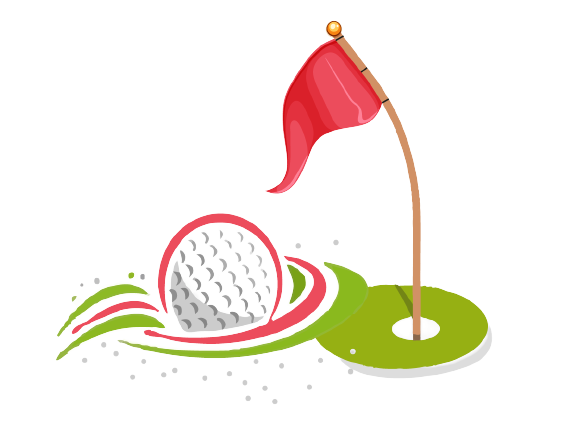Content Summary
Do you ever wonder what lies beneath the surface of a golf ball?
We’ll uncover what makes a golf ball so special and explore the hidden features that make it an essential part of the game.
From the dimples on the surface to the core in the center, we’ll explore the inner workings of the modern golf ball and examine the science behind its performance.
The Anatomy of a Golf Ball
A golf ball is a small spherical object made of a special material that can be hit with a golf club. It has a dimpled surface which is designed to create drag and lift, allowing the ball to travel further and more accurately than any other type of ball.
Inside the golf ball is a core, which is the main component that affects the flight of the ball. This core is made up of a solid rubber core inside or liquid center, surrounded by a layer of synthetic rubber. This helps the ball to remain stable and to travel in a straight line.
The dimples on the exterior of the golf ball are designed to reduce drag and create lift, which helps the ball travel further. The dimples come in a variety of sizes and shapes, each having a unique effect on the ball's trajectory.
The dimples also act as "mini-turbines" which further enhance the lift of the ball. The dimples create a pocket of air around the ball, which helps to reduce drag and increase the lift.
The combination of the core and the dimples are what make up a golf ball and their design makes them so special. The core and dimples work together to ensure the ball travels accurately and consistently, making it an essential part of the game.
With a closer look at the technology and science behind golf balls, we can truly appreciate their complexity and performance.
The Science Behind the Spin
The golf ball is one of the most complex pieces of sporting equipment in the world and there is a great deal of science behind its spin.
The outer surface of the golf ball is composed of a dimpled pattern that is designed to reduce the amount of drag on the ball and to force the air molecules around it to circulate in a controlled manner. This creates lift and spin that can help the ball travel further and be more accurate.
The core of the golf ball is made of a rubber compound that provides the ball with its compression and bounce. This rubber core increases the ball's elasticity and energy transfer and provides the desired spin rate of the ball when it is hit.
The core also affects the trajectory and flight of the ball and helps determine how accurately it will travel.
The golf ball also has an outer layer (how many layers is dependent on the manufacturer) of resin that is designed to protect the core and to give it durability. This protective layer helps the ball to stay in one piece and to resist damage from the clubs and the elements.
All of these components together give the golf ball its unique characteristics and provide it with the spin that makes it so essential to the game.
Examining the Dimples
The dimples of a golf ball are a key component in terms of design and performance. These little indentations on the surface of the ball allow for the ball to be propelled through the air with greater accuracy, precision and ball speed.
The design of the dimples creates a layer of turbulence on the surface of the ball, reducing drag and allowing for more control when it comes to shot selection. In addition to the design, the dimples also act to increase the lift of the ball, allowing for it to gain more distance in the air.
This lift can be further maximized through the use of compression and spin, creating a more effective launch angle.
In order to further understand the physics behind the dimples, it's important to look at the materials used in the construction of the ball.
Typically, a golf ball consists of a solid rubber core, usually made of a rubber compound such as balata, and a rubberized outer layer, usually made of a plastic such as polyurethane. The dimples are then formed by cutting small indentations into the outer layer.
These indentations generate a cushion of air that the ball rides on, thus reducing drag and increasing lift. This creates a more efficient launch angle, allowing for more distance and accuracy.
The dimples of a golf ball are a key component in terms of design and performance, and they have an important role to play in the overall success of a shot.
Exploring the Core
Exploring the golf ball's core helps us to understand the technology and science behind the golf ball.
It helps us understand how the core and casing of the ball interact with the dimples to create the spin and lift that make the ball so effective.
Additionally, it looks at the various technologies and materials used in golf ball manufacturing and how they impact the ball’s performance. From a comparison of different types of balls and there are many, such as one piece golf balls, two piece balls, three piece golf balls, four piece balls, and six piece golf balls, to an exploration of the types of materials used in construction.
At the heart of many golf balls is this small, densely packed core. It is typically composed of a rubber material such as Surlyn or Balata and is surrounded by layers of synthetic rubber and plastic.
The core determines the ball’s bounce, spin and distance, while the outer layers give it the durability it needs to withstand the wear and tear of a round of golf. There are also different types of balls designed for different types of players.
What Makes a Golf Ball Special?
Golf balls have been a part of the game of golf since its inception. The technology behind golf balls has come a long way since the early days, and modern golf balls are a testament to the amazing engineering feats of today.
The core is surrounded by a thin layer of material known as the mantle, which gives the ball its spin. This layer is then wrapped in a durable outer cover made of a material like balata, which gives the ball its shape and durability.
The cover is what gives the ball its distinct characteristics -- the dimples. As we discussed earlier, dimples reduce the air drag on the ball and increase the ball’s lift, allowing it to travel further.
Each golf ball is designed with a specific pattern and depth of dimples, which is why different golf balls fly differently depending on the type of ball you’re using. The dimples are also responsible for the ball’s spin, which can be adjusted by changing the depth and pattern of the dimples.
The best golf balls are truly amazing pieces of engineering and science. From the core to the dimples, each component of the ball has been carefully designed to optimize its performance.
Most golf balls are made with the combination of cutting-edge materials and innovative design that make golf balls a unique and special part of the game.
Conclusion - Unlocking the Secrets of a Golf Ball
The golf ball is one of the most iconic symbols of golf, and for good reason. It is the most important piece of golf gear equipment for any golfer.
For example, the balls used by professional golfers tend to have a harder core and less spin, while recreational players may use softer balls with more spin.
Additionally, the dimples on the surface of the ball are instrumental in its flight. The dimples create a thin layer of air that is then pushed over the surface of the ball in a process called “lift”. The golf ball depends on this lift to perform as golfers require.
This lift helps the ball fly farther and straighter. Dimples also help with spin, which is the secret to accurate shots.
By unlocking the secrets inside golf balls, you are gaining a deeper understanding of the game and potentially improving your performance on the golf course.
So, the next time you are on the tee box, take a closer look at your ball and appreciate the complex technology that lies beneath the surface.
Thank you for visiting, and we hope to see you back soon!








